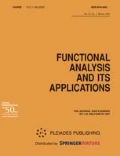Abstract
In the two-dimensional case, the generalized Radon transform takes each function supported in a disk to the values of the integrals of that function over a family of curves. We assume that the curves differ only slightly from straight lines and the network formed by these curves has the same topological structure as the network of straight lines. Thus, the generalized Radon transform specifies a function on the set of straight lines. Under these conditions, we obtain a solution of the inversion problem for the generalized Radon transform and indicate a Cavalieri condition describing the range of this transform in the space of functions on the set of straight lines.
Similar content being viewed by others
References
I. M. Gelfand, M. I. Graev, and N. Ya. Vilenkin, Integral Geometry and Related Questions in Representation Theory, Generalized Functions [in Russian], Issue 5, Fizmatgiz, Moscow, 1967.
I. M. Gelfand, S. G. Gindikin, and M. I. Graev, Selected Problems in Integral Geometry [in Russian], Dobrosvet, Moscow, 2000.
S. Helgason, The Radon Transform, Birkhäuser, Boston-Basel-Stuttgart, 1980.
S. Helgason, Groups and Geometric Analysis. Integral Geometry, Invariant Differential Operators, and Spherical Functions, Academic Press, Orlando etc., 1984.
I. M. Gelfand, M. I. Graev, and Z. Ya. Shapiro, “Differential forms and integral geometry,” Funkts. Anal. Prilozhen., 3, No. 2, 24–40 (1969).
V. Guillemin, “On some results of Gelfand in integral geometry,” In: Pseudodifferential operators and Applications (Notre Dame, Ind., 1984), Proc. Sympos. Pure Math., Vol. 43, Providence, R.I., 1985, pp. 149–155.
V. Guillemin and S. H. Sternberg, Geometric Asymptotics, Amer. Math. Soc., Providence, 1977.
E. T. Quinto, “The dependence of the generalized Radon transform on defining measures,” Trans. Amer. Math. Soc., 257, No. 2, 331–346 (1980).
A. Greenleaf and G. Uhlmann, “Nonlocal inversion formulas for the X-ray transformation,” Duke Math. J., 58, No. 1, 205–240 (1989).
E. M. Stein, Harmonic Analysis: Real Variable Methods, Orthogonality, and Oscillatory Integrals, Princeton University Press, Princeton, 1993.
D. H. Phong, “Regularity of Fourier integral operators,” In: Proc. Intern. Congress of Math., Zurich, 1994, Vol. 2, Birkhauser, Basel, 1995, pp. 862–874.
D. H. Phong and E. M. Stein, “Singular Radon transforms and oscillatory integrals,” Duke Math. J., 58, No. 2, 347–369 (1989).
E. T. Quinto, “Radon transforms on curves in the plane,” In: Tomography, Impedance Imaging, and Integral Geometry, Lectures in Appl. Math., Vol. 30, Amer. Math. Soc., Providence, R.I., 1994, pp. 231–244.
J. Boman and E. T. Quinto, “Support theorems for real-analytical Radon transforms,” Duke Math. J., 55, No. 4, 943–948 (1987).
M. L. Agranovsky and E. T. Quinto, “Injectivity sets for the Radon transform over circles and complete systems of radial functions,” J. Funct. Anal., 139, 383–414 (1996).
A. Greenleaf and G. Uhlmann, “Estimates for singular Radon transforms and pseudodifferential operators with singular symbols,” J. Funct. Anal., 89, 202–239 (1990).
A. A. Thomson, “Sobolev estimates for singular Radon transforms,” J. Funct. Anal., 112, 61–96 (1993).
F. John, Plane Waves and Spherical Means Applied to Partial Differential Equations, Interscience Publishers, Inc., New York, 1955.
R. Courant and D. Hilbert, Methods of Mathematical Physics, Vol. II: Partial Differential Equations (Vol. II by R. Courant), Interscience Publishers, New York, 1962.
M. M. Lavrent'ev, V. G. Vasil'ev, and V. G. Romanov, Multidimensional Inverse Problems for Differential Equations [in Russian], Nauka, Novosibirsk, 1969.
V. G. Romanov, “Reconstructing functions from integrals over a family of curves,” Sib. Mat. Zh., 7, No. 5, 1206–1208 (1967).
A. M. Cormack, “Radon transform on a family of curves in the plane,” I, Proc. Amer. Math. Soc., 83, 325–330 (1981); II, ibid.,86, 293–298 (1982).
P. D. Lax and P. S. Phillips, “The Paley-Wiener theorem for the Radon transform,” Comm. Pure Appl. Math., 23, No. 3, 409–424 (1970).
R. G. Mukhometov, “On a problem in integral geometry,” In: Mathematical Problems of Geophysics [in Russian], No. 6, Novosibirsk, 1975, pp. 212–242.
Yu. E. Anikinov, “On the solvability of a problem in integral geometry,” Mat. Sb., 101 (143), No. 2, 271–279 (1976).
R. G. Mukhometov, “The problem of reconstructing the two-dimensional Riemannian metric and integral geometry,” Dokl. Akad. Nauk SSSR, 232, No. 1, 32–35 (1977).
A. L. Bukhgeim, Introduction to the Theory of Inverse Problems [in Russian], Nauka, Novosibirsk, 1988.
R. B. Marr, “On the reconstruction of a function on a circular domain from a sampling of its line integrals,” J. Math. Anal. Appl., 45, 357–374 (1974).
P. K. Suetin, Orthogonal Polynomials [in Russian], Nauka, Moscow, 1979.
F. Treves, Introduction to Pseudodifferential and Fourier Integral Operators, Vols. 1, 2, Plenum Press, New York-London, 1980.
D. A. Popov, “Estimates with constants for a class of oscillating integrals,” Usp. Mat. Nauk, 52, No. 1, 77–148 (1997).
A. Erdélyi, Asymptotic Expansions, Dover, New York, 1956.
L. Hörmander, “The spectral function of elliptic operator,” Acta Math., 121, Nos. 3–4, 193–218 (1968).
R. S. Deans, The Radon Transform and Some Its Applications, John Wiley and Sons, New York, 1983.
M. Born and E. Wolf, Principles of Optics, Electromagnetic Theory of Propagation, Interference, and Diffraction of Light, Oxford-London-Edinburgh-New York-Paris, 1966.
A. Erdélyi, W. Magnus, F. Oberhettinger, and F. Tricomy, Tables of Integral Transforms, Vol. II, MacGraw-Hill, New York, 1954.
A. P. Prudnikov, Yu. A. Brychkov, and O. I. Marichev, Integrals and Series of Special Functions [in Russian], Nauka, Moscow, 1983.
Author information
Authors and Affiliations
Rights and permissions
About this article
Cite this article
Popov, D.A. The Generalized Radon Transform on the Plane, the Inverse Transform, and the Cavalieri Conditions. Functional Analysis and Its Applications 35, 270–283 (2001). https://doi.org/10.1023/A:1013126507543
Issue Date:
DOI: https://doi.org/10.1023/A:1013126507543


